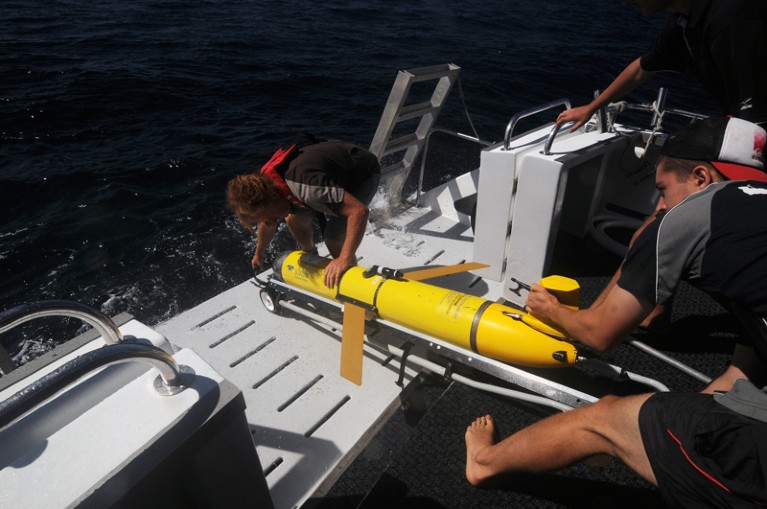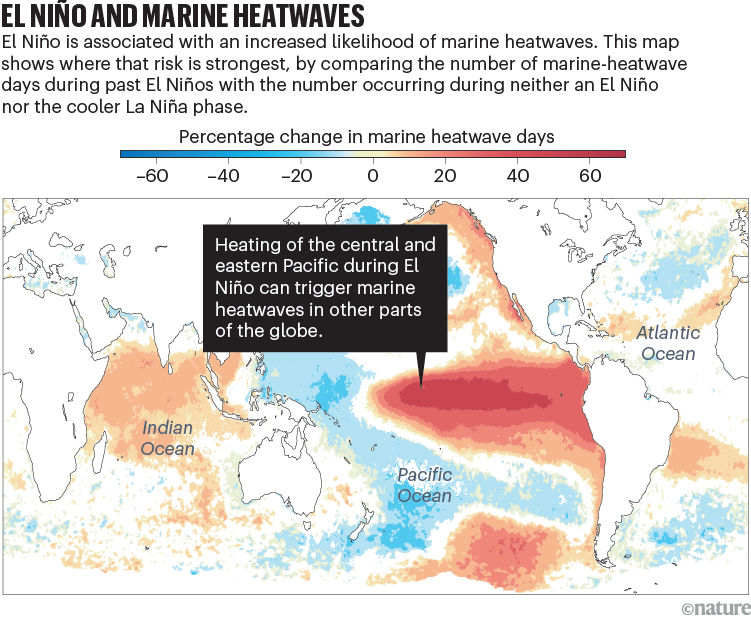With the arrival of El Niño, prepare for stronger marine heatwaves
With the arrival of El Niño, prepare for stronger marine heatwaves Nature.com


Oceans Warming at Alarming Rates: Implications for Sustainable Development Goals
Oceans are warming up, and dangerously so. Since April this year, the average global sea surface temperature has been unusually high and rising; by August, oceans in the Northern Hemisphere had reached record-high temperatures, even surpassing 38 °C in one area around Florida.
These extreme temperatures, fueled by the climate crisis, have manifested as a series of marine heatwaves — periods of anomalously warm sea temperatures that can last for weeks, months, or even years — across the Northern and Southern hemispheres. In some areas around the United Kingdom and Ireland, for example, surface waters in June and July were 4–5 °C warmer than usual for this time of year. Temperatures are also soaring off the coast of Florida and into the Gulf of Mexico, extending across the tropical Pacific, around Japan, and off the coasts of Ecuador and Peru. Marine heatwaves are more intense, last longer, and occur more frequently than in the past. From 1925 to 2016, the number of days experiencing marine heatwaves increased by 54%1.
This makes the concurrent likelihood of a strong El Niño — a climate phenomenon typically associated with a rise in global temperatures — particularly worrying.
Marine Heatwaves and their Impact on Ecosystems
Marine heatwaves disrupt, threaten, and damage ecosystems. They are particularly dangerous for temperature-sensitive organisms that live in cool waters, such as kelps, and immobile warm-water organisms, such as corals. Many species might be susceptible to disease or mortality, with knock-on effects. For example, in 2014–15, a marine heatwave off the west coast of the United States, dubbed the Blob, caused widespread loss of sea stars. This, in turn, caused a bloom of sea urchins (on which sea stars predate), which damaged kelp forests2. Rising water temperatures can also cause some species to migrate to cooler waters.
Such events also affect local communities, including through economic losses from impacts on fisheries and aquaculture. The Peruvian anchoveta (Engraulis ringens), for example, disappears from its usual fishing grounds during marine heatwaves. In 2015–16, the sea off eastern Tasmania in Australia saw high mortality rates for oysters and abalones during a warm spell. Additionally, mass bleaching of coral reefs dents tourism, as white corals do not appeal to snorkelers and divers. The impact of a heatwave on marine industries can run into billions of dollars3.

Credit: Suzanne Long/Alamy
Addressing the Challenges: Sustainable Development Goals
Given the impending overlap of El Niño conditions with long-term warming trends, it is pressing to closely monitor regions with a high likelihood of marine heatwaves and to develop and implement a range of approaches for reducing risks to wildlife and economies. Here, we urge decision-makers in marine and coastal biodiversity conservation, fishing, aquaculture, and tourism industries to devise such a strategy for the coming months as well as for the decades ahead. We set out four priorities.
1. Identify Threatened Regions
Where communities are prepared, impacts can be mitigated, at least partially. This depends on knowing which regions are most likely to be affected.
An analysis of historical data can reveal which areas experienced marine heatwaves during previous El Niños and suggests where such events are most likely to occur when it develops: in the northeast Pacific (affecting coastal waters from California to the eastern Bering Sea); the tropical central-to-eastern Pacific and the shelf waters of Ecuador and Peru; off eastern Australia; and the Indian Ocean, including off the east coast of Africa, southern India, and southeast Asia. These areas are known to be susceptible to mass die-offs of diverse marine habitats, from tropical coral reefs to temperate kelp forests4.

El Niño occurs as part of a cycle, but this is not the only climate cycle to influence marine heatwaves. Other ocean and atmospheric patterns operate on timescales ranging from a few
SDGs, Targets, and Indicators
| SDGs | Targets | Indicators |
|---|---|---|
| SDG 13: Climate Action | Target 13.1: Strengthen resilience and adaptive capacity to climate-related hazards and natural disasters | Indicator not mentioned in the article |
| SDG 14: Life Below Water | Target 14.1: By 2025, prevent and significantly reduce marine pollution of all kinds | Indicator not mentioned in the article |
| Target 14.2: By 2020, sustainably manage and protect marine and coastal ecosystems to avoid significant adverse impacts, including by strengthening their resilience, and take action for their restoration in order to achieve healthy and productive oceans | Indicator not mentioned in the article | |
| SDG 15: Life on Land | Target 15.5: Take urgent and significant action to reduce the degradation of natural habitats, halt the loss of biodiversity, and protect and prevent the extinction of threatened species | Indicator not mentioned in the article |
| Target 15.9: By 2020, integrate ecosystem and biodiversity values into national and local planning, development processes, poverty reduction strategies, and accounts | Indicator not mentioned in the article |
1. Which SDGs are addressed or connected to the issues highlighted in the article?
The issues highlighted in the article are connected to SDG 13: Climate Action, SDG 14: Life Below Water, and SDG 15: Life on Land.
2. What specific targets under those SDGs can be identified based on the article’s content?
- Target 13.1: Strengthen resilience and adaptive capacity to climate-related hazards and natural disasters
- Target 14.1: By 2025, prevent and significantly reduce marine pollution of all kinds
- Target 14.2: By 2020, sustainably manage and protect marine and coastal ecosystems to avoid significant adverse impacts, including by strengthening their resilience, and take action for their restoration in order to achieve healthy and productive oceans
- Target 15.5: Take urgent and significant action to reduce the degradation of natural habitats, halt the loss of biodiversity, and protect and prevent the extinction of threatened species
- Target 15.9: By 2020, integrate ecosystem and biodiversity values into national and local planning, development processes, poverty reduction strategies, and accounts
3. Are there any indicators mentioned or implied in the article that can be used to measure progress towards the identified targets?
No specific indicators are mentioned or implied in the article that can be used to measure progress towards the identified targets.
4. Table: SDGs, Targets, and Indicators
| SDGs | Targets | Indicators |
|---|---|---|
| SDG 13: Climate Action | Target 13.1: Strengthen resilience and adaptive capacity to climate-related hazards and natural disasters | Indicator not mentioned in the article |
| SDG 14: Life Below Water | Target 14.1: By 2025, prevent and significantly reduce marine pollution of all kinds | Indicator not mentioned in the article |
| Target 14.2: By 2020, sustainably manage and protect marine and coastal ecosystems to avoid significant adverse impacts, including by strengthening their resilience, and take action for their restoration in order to achieve healthy and productive oceans | Indicator not mentioned in the article | |
| SDG 15: Life on Land | Target 15.5: Take urgent and significant action to reduce the degradation of natural habitats, halt the loss of biodiversity, and protect and prevent the extinction of threatened species | Indicator not mentioned in the article |
| Target 15.9: By 2020, integrate ecosystem and biodiversity values into national and local planning, development processes, poverty reduction strategies, and accounts | Indicator not mentioned in the article |
Behold! This splendid article springs forth from the wellspring of knowledge, shaped by a wondrous proprietary AI technology that delved into a vast ocean of data, illuminating the path towards the Sustainable Development Goals. Remember that all rights are reserved by SDG Investors LLC, empowering us to champion progress together.
Source: nature.com

Join us, as fellow seekers of change, on a transformative journey at https://sdgtalks.ai/welcome, where you can become a member and actively contribute to shaping a brighter future.







